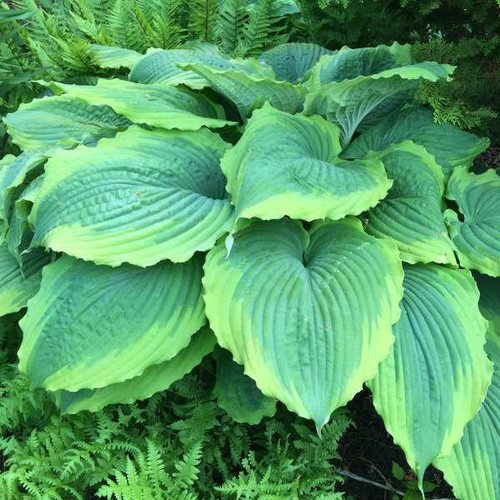Product Description
Sisyrinchium angustifolium 'Lucerne' (25) Bare Root Plants
Common name: Blue-Eyed Grass, formerly Sisyrinchium bermudianum.
Spiky, dark green, fan-like clumps of narrow, stiff grass-like foliage gives way to bright purplish-blue flowers with six pointed tepals and gold centers. One inch blooms appear the heaviest in late spring and early summer. Plants may continue to bloom sporadically all summer long.
This plant is very low maintenance. It will grow in full sun or partial shade and prefers average to rich, well-drained soil. Prefers consistently moist soils that do not dry out, but drainage must be good. Plants spread slowly to form thick clumps. Plantings may be sheared back after bloom to tidy foliage for remaining part of the growing season. Divide after flowering if desired. 'Lucerne' does not vigorously self-seed as often as species plants.
This is a great little plant for accents along walkways or in rockeries. It has a very unique look. Though it looks like it belongs to the family of plants, it is actually a relative of the Iris family.
Height: 10.0 Inches
Spread: 15.0 Inches
Hardiness Zones: 5,6,7,8
Flower Color: Purple-blue shades
Foliage Color: Green shades
Full Sun (> 6 hrs. Direct Sun) - Part Shade (4-6 hrs. Direct Sun)
Average to Consistent Water Needs
Poor to Average Soil Quality
Bloomtime: Late Spring - Early Summer
Growth Rate: Medium
Border Plant, Edging, Ground Cover
Sisyrinchium angustifolium 'Lucerne' is a charming and low-maintenance perennial that adds a touch of delicate beauty to the garden. Here is a breakdown of its key features:
Appearance:
- Foliage: Features narrow, grass-like leaves that form a neat, tufted clump. The foliage is typically a dark green color, providing a nice backdrop for the flowers.
- Flowers: Produces star-shaped, bright blue flowers with yellow centers. The flowers are larger than those of the species, about 1 inch in diameter, and are borne on branched stems that rise above the foliage.
- Form: Grows in a compact, upright clump, typically reaching about 10-12 inches in height and 12-15 inches in spread.
Growing Conditions:
- Sunlight: Prefers full sun to part shade. It blooms best in full sun but can tolerate some light shade.
- Soil: Thrives in moist, well-drained soil. It can tolerate a variety of soil types, including clay, loam, and sand, as long as the drainage is good.
- Water: Needs regular watering, especially during dry spells. It prefers consistently moist soil but does not like to sit in waterlogged conditions.
- Hardiness Zones: Hardy in USDA zones 5-9, making it adaptable to a wide range of climates.
Benefits:
- Beautiful Flowers: The bright blue flowers with yellow centers provide a cheerful display in late spring and early summer.
- Low Maintenance: Easy to care for and requires minimal attention.
- Versatile: Can be used in a variety of garden settings, including borders, rock gardens, cottage gardens, and naturalized areas.
- Attracts Pollinators: The flowers attract butterflies and other beneficial insects.
- Deer Resistant: Generally, not bothered by deer.
Care Tips:
- Planting: Plant in spring or fall. Space plants about 12-15 inches apart.
- Watering: Water regularly, especially during dry spells.
- Fertilizing: Apply a balanced fertilizer in spring before new growth begins.
- Pruning: Shear back the foliage after flowering to tidy up the plant and prevent self-seeding.
- Division: Divide clumps every 2-3 years to maintain vigor.
Sisyrinchium angustifolium 'Lucerne' is a great choice for gardeners who want a low-maintenance, attractive plant that adds a touch of blue to the garden. Its versatility and ease of care make it a welcome addition to any landscape.
Other Details
The most important part of the plant is its root system. Healthy roots are the foundation of a healthy, vibrant plant. The type of plug container used is based on the specific needs of the plants. Perennials offered as bare root traditionally perform better when planted as bare root.Planted in a specialized mix, potted plants have well established root systems. Top growth stage will vary depending on the current life cycle and time of year when shipped. In Winter and early Spring dormant plants may be shipped. Dormant plants may be planted right away, even before the last frost date.
Most bare root varieties are field grown for at least one season, though Hemerocallis and Hosta are grown for two seasons. The bulk of the soil is removed during the harvesting process and the tops of most varieties are trimmed back to the crown. They are graded, packed in shredded aspen or sphagnum moss and stored in freezers until ready to be shipped.
See our Container Sizes and Bare Root Perennials pages for more information.
Plant information and care is provided in the Overview section, Plant Genus Page and general information is provided in the Planting Care & Guides. Additional questions can be asked on each Plant page.
Plant Spacing: Using the maximum mature spread or width of a plant to guide spacing, ensures space to grow to full size. To fill an area sooner, plant them closer together. Just remember, future thinning or transplanting may be needed.
Water: Keep a close eye on newly planted perennials, especially throughout the first growing year. Most early plant loss is due to too much or too little water!









